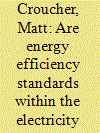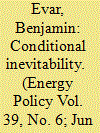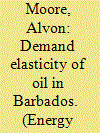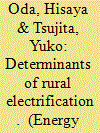|
|
|
Sort Order |
|
|
|
Items / Page
|
|
|
|
|
|
|
| Srl | Item |
| 1 |
ID:
105798


|
|
|
|
|
| Publication |
2011.
|
| Summary/Abstract |
A spatially explicit agent-based vehicle consumer choice model is developed to explore sensitivities and nonlinear interactions between various potential influences on plug-in hybrid vehicle (PHEV) market penetration. The model accounts for spatial and social effects (including threshold effects, homophily, and conformity) and media influences. Preliminary simulations demonstrate how such a model could be used to identify nonlinear interactions among potential leverage points, inform policies affecting PHEV market penetration, and help identify future data collection necessary to more accurately model the system. We examine sensitivity of the model to gasoline prices, to accuracy in estimation of fuel costs, to agent willingness to adopt the PHEV technology, to PHEV purchase price and rebates, to PHEV battery range, and to heuristic values related to gasoline usage. Our simulations indicate that PHEV market penetration could be enhanced significantly by providing consumers with ready estimates of expected lifetime fuel costs associated with different vehicles (e.g., on vehicle stickers), and that increases in gasoline prices could nonlinearly magnify the impact on fleet efficiency. We also infer that a potential synergy from a gasoline tax with proceeds is used to fund research into longer-range lower-cost PHEV batteries.
|
|
|
|
|
|
|
|
|
|
|
|
|
|
|
|
| 2 |
ID:
105750


|
|
|
|
|
| Publication |
2011.
|
| Summary/Abstract |
The paper analyzes Iran's oil export capacity and the factors affecting it. First, the local energy demand is reviewed and crude oil, with 5.7% annual growth rate, is introduced as a major source to respond to the increasing domestic energy demand. Then, the national plans for controlling the local demand and replacing oil with other types of energy carriers are reviewed to create a view over the future of local demand for crude oil in Iran. In the next step, crude oil production and exploration situation in Iran are investigated and the required increase in production to maintain the present level of export is calculated. By estimating the average capital expenditures for adding each barrel of new capacity to Iran's daily oil production, the necessary annual investment to compensate the production drop and domestic consumption growth for maintaining the export is introduced. Then, the future of oil export in Iran is predicted in three optimistic, reference, and pessimistic scenarios on the basis of the country's ability in managing the financial resources in upstream oil industry. Finally, domestic and foreign investment and the history of buyback contracts and their undeniable role in development of Iranian oil and gas projects are discussed.
|
|
|
|
|
|
|
|
|
|
|
|
|
|
|
|
| 3 |
ID:
105778


|
|
|
|
|
| Publication |
2011.
|
| Summary/Abstract |
There is a growing trend to introduce energy efficiency standards at the state level. We examine why electricity utilities may be in favor of such a standard and conclude that energy efficiency standards may be a form of regulatory capture.
|
|
|
|
|
|
|
|
|
|
|
|
|
|
|
|
| 4 |
ID:
105754


|
|
|
|
|
| Publication |
2011.
|
| Summary/Abstract |
This work aims at the development of an integrated model for analysis and optimization of operating strategies of Water Distribution Systems (WDS), taking into consideration economical-hydraulic-power performances. For this purpose, a software tool has been developed based on the following procedures: (i) an Artificial Neural Network (ANN) to determine the best economical hybrid energy system; (ii) for the ANN training process an energy Configuration type and Economical base Simulator model (CES) is used; (iii) as well a Hydraulic and Power Simulator model (HPS) to describe the hydraulic system behaviour; (iv) a performance assessment tool based on an optimization module to minimize pumping costs and maximize the hydraulic reliability and energy efficiency is then implemented. The Artificial Neural Network uses scenarios with only grid supply, grid combined with hydro-turbine, or with wind turbine and a mutual solution, with hydro and wind turbine. The results obtained show how the model is useful for decision support solutions in the planning of sustainable hybrid energy solutions that can be applied to water distribution systems or others existent hydro-systems, allowing the improvement of the global energy efficiency. A real case study of a small WDS in Portugal is analyzed.
|
|
|
|
|
|
|
|
|
|
|
|
|
|
|
|
| 5 |
ID:
105755


|
|
|
|
|
| Publication |
2011.
|
| Summary/Abstract |
This review paper deals with colligated aspects of the BioPlus Project (ERA-ARD) implemented by Institute of Technology and Life Sciences (Poland) and Lithuanian University of Agriculture Institute of Agro-Engineering (Lithuania) in cooperation with National University of Life and Environmental Sciences of Ukraine Institute of Ecobiotechnologies and Bioenergy (Ukraine). The drawn inferences intended to be an auxiliary material for policy makers and can briefly indicate on direction of the regional development of rural Ukraine, focusing on: (i) country's specific and sub-regional assessments of renewable energy potentials and spheres of its application; (ii) identification of major barriers for the expansion of renewable energy technologies and policy guidance to overcome those barriers; (iii) recommendations for future actions and strategies concerning renewable energy in Ukraine. The article concludes that low contribution of bioenergy towards rural development is to a large extent driven by energy policy that inhibits the delivery and use of modern energy sources in rural Ukraine. Consequently, an incentive for achieving bioenergy's future that has greater relevance to development of the Ukraine's regions requires a mix of policy tools and institutional actions, briefly summarized in this paper.
|
|
|
|
|
|
|
|
|
|
|
|
|
|
|
|
| 6 |
ID:
105742


|
|
|
|
|
| Publication |
2011.
|
| Summary/Abstract |
In this paper, characteristics of the prices of reserves and regulation services in the Ontario, New York and ERCOT electricity markets are studied. More specifically, price variability, price jumps, long-range correlation, and non-linearity of the prices are analyzed using the available measures in the literature. For the Ontario electricity market, the prices of 10-min spinning, 10-min non-spinning, and 30-min operating reserves for the period May 1, 2002 to December 31, 2007 are analyzed. For the New York market, prices of the same reserves plus regulation service are studied for the period February 5, 2005 to December 31, 2008. For the ERCOT market, we analyze the prices of responsive reserve, regulation up and regulation down services, for the period January 1, 2005 to December 31, 2009. The studied characteristics of operating reserve and regulation prices are also compared with those of energy prices. The findings of this paper show that the studied reserve and regulation prices feature extreme volatility, more frequent jumps and spikes, different peak price occurrence time, and lower predictability, compared to the energy prices.
|
|
|
|
|
|
|
|
|
|
|
|
|
|
|
|
| 7 |
ID:
105748


|
|
|
|
|
| Publication |
2011.
|
| Summary/Abstract |
China's vehicle population is widely forecasted to grow 6-11% per year into the foreseeable future. Barring aggressive policy intervention or a collapse of the Chinese economy, we suggest that those forecasts are conservative. We analyze the historical vehicle growth patterns of seven of the largest vehicle producing countries at comparable times in their motorization history. We estimate vehicle growth rates for this analogous group of countries to have 13-17% per year-roughly twice the rate forecasted for China by others. Applying these higher growth rates to China results in the total vehicle fleet reaching considerably higher volumes than forecasted by others, implying far higher global oil use and carbon emissions than projected by the International Energy Agency and others.
|
|
|
|
|
|
|
|
|
|
|
|
|
|
|
|
| 8 |
ID:
105781


|
|
|
|
|
| Publication |
2011.
|
| Summary/Abstract |
Several countries are currently discussing whether they will rebuild their nuclear power stations in order to continue this type of energy production in the future. The public, with its own opinion about nuclear power stations, has an influential voice in this discussion. As a result, policy makers and nuclear scientists are interested in the public's perception of nuclear power and in what determines this perception. We therefore examined an explanatory model of the public's acceptance of nuclear power based on a telephone survey among a representative sample in Switzerland. The model included such factors as risk perception, benefit perception, affective feelings, and social trust. Moreover, we distinguished between two types of benefit perception: benefit for the climate and a secure energy supply. The model fitted very well to our data and explained acceptance very well. Acceptance was mainly influenced by perceived benefits for a secure energy supply and, to a lesser extent, both by perceived benefits for the climate and by risk perception. Affective feelings about nuclear power appeared to be a central factor in the model. Implications for communication about nuclear power stations and for further research are discussed.
|
|
|
|
|
|
|
|
|
|
|
|
|
|
|
|
| 9 |
ID:
105761


|
|
|
|
|
| Publication |
2011.
|
| Summary/Abstract |
Concerns about climate change and energy security have been major arguments used to justify the recent return of nuclear power as a serious electricity generation option in various parts of the world. This article examines the recent public discussion in Finland, France, and the UK - three countries currently in the process of constructing or planning new nuclear power stations. To place the public discussion on nuclear power within the relationship between policy discourses and contexts, the article addresses three interrelated themes: the justifications and discursive strategies employed by nuclear advocates and critics, the similarities and differences in debates between the three countries, and the interaction between the country-specific state orientations and the argumentation concerning nuclear power. Drawing from documentary analysis and semi-structured interviews, the article identifies and analyses key discursive strategies and their use in the context of the respective state orientations: 'technology-and-industry-know-best' in Finland, 'government-knows-best' in France, and 'markets-know-best' in the UK. The nuclear debates illustrate subtle ongoing transformations in these orientations, notably in the ways in which the relations between markets, the state, and civil society are portrayed in the nuclear debates.
|
|
|
|
|
|
|
|
|
|
|
|
|
|
|
|
| 10 |
ID:
105803


|
|
|
|
|
| Publication |
2011.
|
| Summary/Abstract |
Although wind power is currently the most efficient source of renewable energy, the installation of wind turbines (WT) in landscapes often leads to conflicts in the affected communities. We propose that such conflicts can be mitigated by a welfare-optimal spatial allocation of WT in the landscape so that a given energy target is reached at minimum social costs. The energy target is motivated by the fact that wind power production is associated with relatively low CO2 emissions. Social costs comprise energy production costs as well as external costs caused by harmful impacts on humans and biodiversity. We present a modeling approach that combines spatially explicit ecological-economic modeling and choice experiments to determine the welfare-optimal spatial allocation of WT in West Saxony, Germany. The welfare-optimal sites balance production and external costs. Results indicate that in the welfare-optimal allocation the external costs represent about 14% of the total costs (production costs plus external costs). Optimizing wind power production without consideration of the external costs would lead to a very different allocation of WT that would marginally reduce the production costs but strongly increase the external costs and thus lead to substantial welfare losses.
|
|
|
|
|
|
|
|
|
|
|
|
|
|
|
|
| 11 |
ID:
105723


|
|
|
|
|
| Publication |
2011.
|
| Summary/Abstract |
China is quickly building up its nuclear power capacity while the hailed nuclear renaissance in the United States has been largely stagnant. The political and industrial structures explain the divergent paths. This paper draws lessons from the French experiences in deploying nuclear power and uses the lessons in comparing Chinese and U.S. policies. An authoritative political system and state-owned utility industry allow China to emulate the French approaches such as government-backed financing and broad-scale deployment with standardized design. The democratic political system and fragmented utility industry, and the laissez-faire ideology in the United States, on the other hand, are unfavorable to a nuclear renaissance. The prospect of a nuclear revival in the United States remains highly uncertain.
As China builds up its nuclear industry, it will be able to reduce carbon emissions without a carbon price through a national plan to deploy low-carbon nuclear electricity, while the United States cannot implement a climate policy without a carbon price. American politicians should stop using China's lack of carbon cap as an excuse for postponing the legislation of a carbon price.
|
|
|
|
|
|
|
|
|
|
|
|
|
|
|
|
| 12 |
ID:
105759


|
|
|
|
|
| Publication |
2011.
|
| Summary/Abstract |
This paper presents findings on expert perceptions of uncertainty in carbon capture and storage (CCS) technology and policy in the UK, through survey data and semi-structured interviews with 19 individual participants. Experts were interviewed in industry, research, and non-governmental organisations (NGOs) in the summer of 2009 and were asked to comment on a range of technical processes as well as policy concerns. The survey revealed that perceptions of the technology conform to a 'certainty trough' with users expressing the lowest level of uncertainty, and outsiders expressing the highest level of uncertainty. The interviews revealed that experts express certitude in the prospects for deploying large-scale CCS technology in the UK, all the while questioning several underlying technical and policy premises that are necessary to ensure this goal.
|
|
|
|
|
|
|
|
|
|
|
|
|
|
|
|
| 13 |
ID:
105746


|
|
|
|
|
| Publication |
2011.
|
| Summary/Abstract |
Climate change mitigation and security of energy supply are important targets of Austrian energy policy. Bioenergy production based on resources from agriculture and forestry is an important option for attaining these targets. To increase the share of bioenergy in the energy supply, supporting policy instruments are necessary. The cost-effectiveness of these instruments in attaining policy targets depends on the availability of bioenergy technologies. Advanced technologies such as second-generation biofuels, biomass gasification for power production, and bioenergy with carbon capture and storage (BECCS) will likely change the performance of policy instruments. This article assesses the cost-effectiveness of energy policy instruments, considering new bioenergy technologies for the year 2030, with respect to greenhouse gas emission (GHG) reduction and fossil fuel substitution. Instruments that directly subsidize bioenergy are compared with instruments that aim at reducing GHG emissions. A spatially explicit modeling approach is used to account for biomass supply and energy distribution costs in Austria. Results indicate that a carbon tax performs cost-effectively with respect to both policy targets if BECCS is not available. However, the availability of BECCS creates a trade-off between GHG emission reduction and fossil fuel substitution. Biofuel blending obligations are costly in terms of attaining the policy targets.
|
|
|
|
|
|
|
|
|
|
|
|
|
|
|
|
| 14 |
ID:
105806


|
|
|
|
|
| Publication |
2011.
|
| Summary/Abstract |
In reviewing the journal literature on the decoupling of energy use and industrial output in the Asian region, particularly with respect to developing countries, we found little information about most country programs other than for China and India and only one article that compared the programs of these two countries. For this reason, we used diverse sources to identify the key programmatic features that have contributed, but clearly are not totally responsible for, decoupling achievements of two countries ( China and Thailand) and then, on the basis of these findings, reviewed emerging industrial energy decoupling programs in four other countries (India, Indonesia, Malaysia and Vietnam). We found that the design of the two successful on-going decoupling programs have common features, which are setting an explicit target for decoupling of energy use and industrial output, a government program that offers financial incentives and imposes specific auditing and reporting requirements and involvement of the manufacturing sector in designing and implementing targets as they apply to individual enterprises. We also found that the emerging programs in the other four countries lack some or all of these essential programmatic features.
|
|
|
|
|
|
|
|
|
|
|
|
|
|
|
|
| 15 |
ID:
105768


|
|
|
|
|
| Publication |
2011.
|
| Summary/Abstract |
How to sustain rapid economic and urban growth with minimised detriment to environment is a key challenge for sustainable development and climate change mitigation in developing countries, which face constraints of technical and financial resources scarcity as well as dearth of infrastructure governance capacity. This paper attempts to address this question by investigating the driving forces of transport demand and relevant policy measures that facilitate mitigating GHG emissions in the urban transport sector in Indian cities based on a critical review of the literature. Our overview of existing literature and international experiences suggests that it is critical to improve urban governance in transport infrastructure quality and develop efficient public transport, coupled with integrated land use/transport planning as well as economic instruments. This will allow Indian cities to embark on a sustainable growth pathway by decoupling transport services demand of GHG emissions in the longer term. Appropriate policy instruments need to be selected to reconcile the imperatives of economic and urban growth, aspiration to higher quality of life, improvements in social welfare, urban transport-related energy consumption and GHG emissions mitigation target in Indian cities.
|
|
|
|
|
|
|
|
|
|
|
|
|
|
|
|
| 16 |
ID:
105769


|
|
|
|
|
| Publication |
2011.
|
| Summary/Abstract |
The importation of oil is a significant component of Barbados' imports, rising from 7% of imports in 1998 to over 20% in 2009. This increase has impacted greatly on the level of foreign reserves. As a price-taker, relying entirely on imported oil for our energy needs could prove a continuous drain on the economy. With a view to formulating an appropriate energy policy for Barbados, this paper analyses the demand for oil using monthly data from 1998 to 2009. The paper estimates the elasticities of demand for oil by employing PesAran (2001) single equation cointegration approach and comparing the results with countries that rely heavily on imported oil and whose policy objective are to alter their energy structure to rely less on imported oil. The results show that the demand for oil imports is price inelastic in the long run. The consumption of oil is responsive to past consumption, prices, income, electricity consumption and the number of appliances imported in the short-run. A policy framework to reduce the use of oil for electricity consumption via alternative energy sources should be considered and the taxation of oil imports given its elasticity is a good source of revenue.
|
|
|
|
|
|
|
|
|
|
|
|
|
|
|
|
| 17 |
ID:
105773


|
|
|
|
|
| Publication |
2011.
|
| Summary/Abstract |
This research sets out to explore the possibilities for further saving in household electricity consumption through a study of the residents' willingness and behavioural characteristics in electricity saving, as applied within a Chinese context. Based on an extensive literature review, the authors argue that economic benefits, policy and social norms, and past experience may have a positive correlation with household electricity-saving behaviour, while the discomfort caused by electricity-saving activities, may exert a negative effect on it. Through a sample of 816 randomly selected residents in Beijing, the propositions are examined using logit regression analysis. The conclusions support the ideas, concerning both the positive influence of economic benefits, policy and social norms, and past experience as they affect broader electricity-saving behaviour, and the negative influence of the discomfort caused by electricity-saving activities. Finally, some inferences are drawn, and suggestions are offered for policy makers and further studies.
|
|
|
|
|
|
|
|
|
|
|
|
|
|
|
|
| 18 |
ID:
105731


|
|
|
|
|
| Publication |
2011.
|
| Summary/Abstract |
This paper explores intra-state disparity in access to electricity and examines the determinants of electrification at the village level in Bihar, one of the underdeveloped states in India. Our field survey of 80 villages in 5 districts conducted in 2008-09 found that 48 villages (60%) are electrified when using the definition of electrification that a village is electrified if any one household in the village is connected to electricity. In the processes of electrification, approximately 40% of villages have been electrified in recent years. The econometric analyses demonstrate that location is the most important determinant of a village's electricity connection. Another important finding is that with the rapid progress of rural electrification under the recent government program and the tendency to connect the villages that are easily accessible, the collective bargaining power of the village, which used to significantly affect the process of electrification, has lost influence. This adversely affects remote villages. In order to extend electricity supplies to remote and geographically disadvantaged villages, the government needs to consider other options for sustainable electricity supply, such as decentralized distribution of electricity rather than the conventional connection through the national/local grids.
|
|
|
|
|
|
|
|
|
|
|
|
|
|
|
|
| 19 |
ID:
105749


|
|
|
|
|
| Publication |
2011.
|
| Summary/Abstract |
In order to cope with climate change, the development and deployment of Hydrogen Fuel Cell Vehicles (HFCVs) is becoming more important. In this study, we developed a forecasting model for HFCVs based on the generalized Bass diffusion model and a simulation model using system dynamics. Through the developed model, we could forecast that the saturation of HFCVs in Korea can be moved up 12 years compared with the US. A sensitivity analysis on external variables such as price reduction rates of HFCVs and number of hydrogen refueling stations is also conducted. The results of this study can give insights on the effects of external variables on the market penetration of HFCVs, and the developed model can also be applied to other studies in analyzing the diffusion effects of HFCVs.
|
|
|
|
|
|
|
|
|
|
|
|
|
|
|
|
| 20 |
ID:
105797


|
|
|
|
|
| Publication |
2011.
|
| Summary/Abstract |
Traditionally the majority of building energy use has been linked to its operation (heating, cooling, lighting, etc.), and much attention has been directed to reduce this energy use through technical innovation, regulatory control and assessed through a wide range of rating methods. However buildings generally employ an increasing amount of materials and systems to reduce the energy use in operation, and energy embodied in these can constitute an important part of the building's life cycle energy use. For buildings with 'zero-energy' use in operation the embodied energy is indeed the only life cycle energy use. This is not addressed by current building energy assessment and rating methods.
This paper proposes a methodology to extend building energy assessment and rating methods accounting for embodied energy of building components and systems. The methodology is applied to the EU Building Energy Rating method and, as an illustration, as implemented in Irish domestic buildings. A case study dwelling is used to illustrate the importance of embodied energy on life cycle energy performance, particularly relevant when energy use in operation tends to zero. The use of the Net Energy Ratio as an indicator to select appropriate building improvement measures is also presented and discussed.
|
|
|
|
|
|
|
|
|
|
|
|
|
|
|
|
|
|
|
|
|